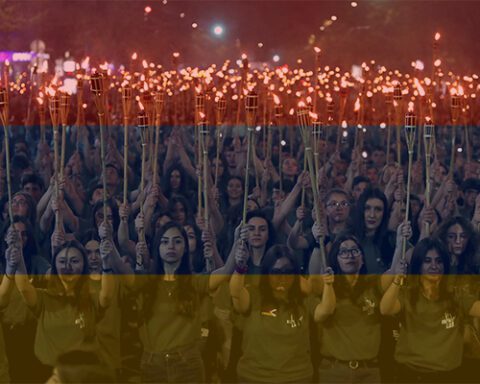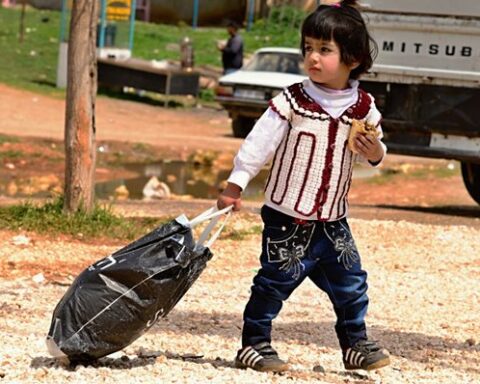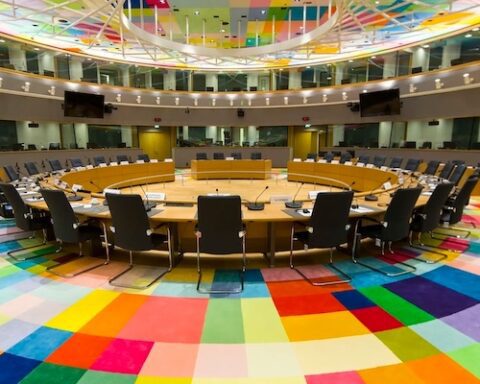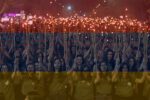Two teams of Islamic State fighters struck civilian targets throughout Tehran early June 7. The teams attacked the Iranian Parliament and the mausoleum of Ayatollah Khomeini, resulting in at least 17 dead and over 40 wounded. The attacks are the first of their kind against the otherwise highly secure Iranian capital, whereas the capitals of Iraq, Syria, and Afghanistan, see these attacks on a dishearteningly regular basis.
The significance is immense and should not be understated, particularly as the Islamic State chose to execute them at the height of the holiest month in Islam – Ramadan. The Iranian government’s security apparatus is, by far, one of the most efficient services in the region. It has historically been ruthless in its persecution of those that threaten its citizens, and the stability of the regime, squashing civil protests, and nefarious militants alike.
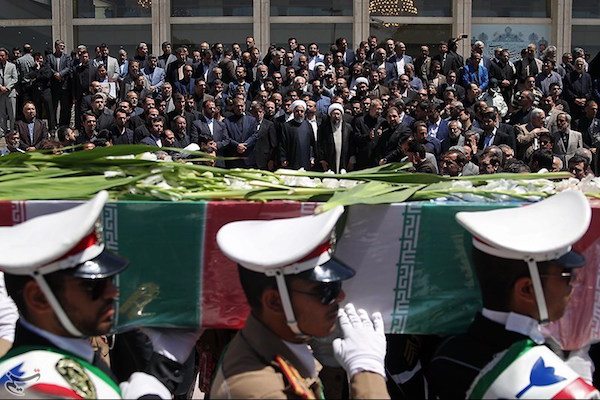
As the attacks were underway, the Islamic State claimed responsibility. Iranian security services have in the aftermath stated that several of the attackers were known Islamic State fighters of Iranian origin.
The Islamic Revolutionary Guard Corps (IRGC) deployed its Saberin Unit, a special forces styled counter-terrorism unit, to the parliament building scene. The Saberin unit received additional support from the IRGC sharp shooter school, sniper training facility, and special forces base located outside of Tehran. Two sniper teams took up positions around the parliament building. The units were commanded by Brigadier General Mohammad Pakpour. Shortly after arriving, and amidst reports of hostages being threatened, a team of 10 special forces members made their way to the upper floors of the parliament, killing one of the assailants as they entered the main room. Two other gunmen on the floor opened fire against the entering members of the counter terrorism force, with a third readying to fire against hostages. The attacker threatening the hostages was incapacitated in short order. A third attempted to detonate his suicide vest, but was neutralized before being able to do so. There were no survivors of the four gunmen inside the parliament building.
An additional Saberin unit was dispatched to the mausoleum scene, but the situation had been largely handled by the on-scene security forces. By that time, only one of the mausoleum attackers was still alive. At present, reports are conflicting. It appears that the attack teams consisted of seven male individuals in total of Iranian origin. Of the seven attackers, all but one died during the security forces’ response to the situation.
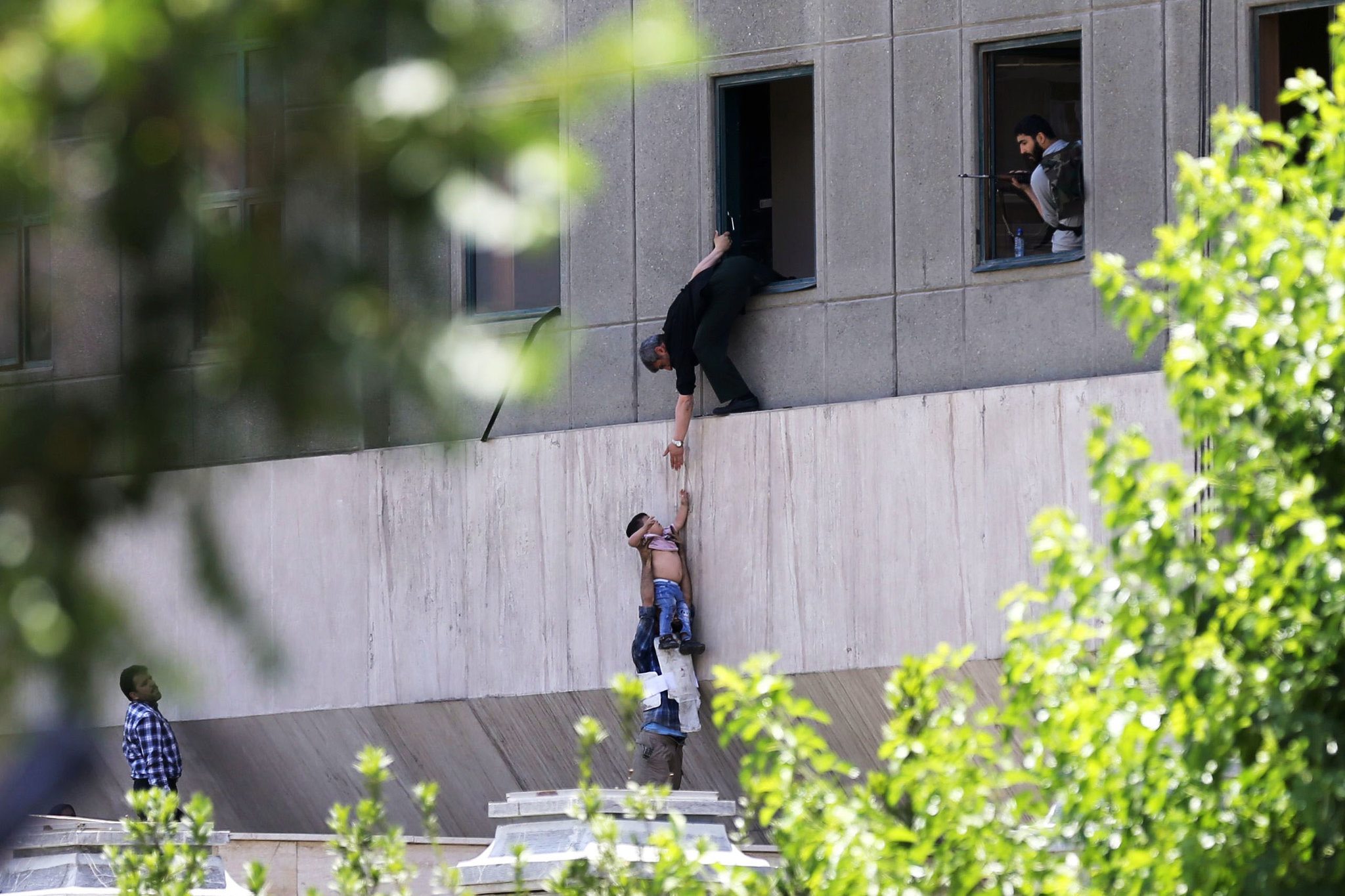
Iranian authorities have arrested five Iranian nationals, including one female, for aiding and abetting in the attacks, in addition to the one survivor from the attack teams. The authorities identified the attackers as coming from primarily rural areas of Iran, in particular, the village of Paveh in the western provinces of Karmanshah. They reportedly had a history of engaging in activities “related to Wahabbi and takfiri groups”.
Amongst the attackers was the known Islamic State recruiter Saryas Sadeghi. Other attackers were identified by their first names only; Abu Jahad, Ghayom, Fereidoun, and Ramin. At least two of the attackers were known to the Ministry of Intelligence as having returned to Iran in August 2016 under the command of the Islamic State commander Abu Ayesheh. Attempts to detain the individuals were made, but they were able to slip away. A raid of the location where the individuals were believed to be kept was carried out by security forces. The raid resulted in the death of Abu Ayesheh and a number of his men. The individuals that escaped are believed to have fled into Syria, and traveled to al Raqqa City, the capital of the self-declared Islamic State’s caliphate.
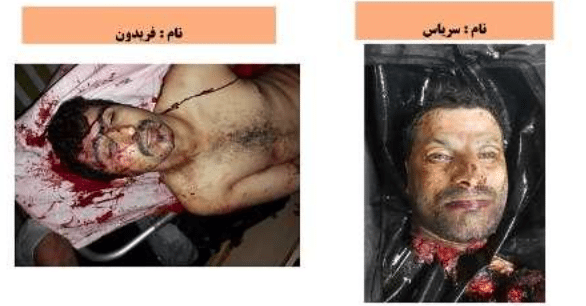
ISIS’s conduct clearly benefits the Iranian regime’s Supreme Leader Khamenei, who wholeheartedly welcomes it as an opportunity to overcome his regime’s regional and international impasse and isolation. The founder and the number one state sponsor of terror is thus trying to switch the place of murderer and the victim and portray the central banker of terrorism as a victim.
-Maryam Rajavi, President-elect, National Council of Resistance of Iran
With these attacks, the Islamic State seeks to punish, and damage, one of its premier enemies on the battlefield in Syria. The targets, parliament and the mausoleum of the founding father of the regime, mark a serious attack on the Iranian governing system and ideology. In subsequent communiques, the group has vowed to continue to strike against Iran. The Islamic State is desperately trying to remain relevant, in its current state, as it is quickly losing its strategic foothold throughout the region. By committing to several acts of large scale terror before its self-declared caliphate is destroyed, in the physical sense, they are attempting to create a legacy that will outlive the current arrangement and carry on as the Islamic State morphs into its next variation.
In the early hours after the attack, some indicators implied that it was not the Islamic State that had orchestrated the attacks. It was suspected that it could be the Mojahedin-e Khalq movement, or People’s Mojahedin Organization in Iran. Often abbreviated as MEK or MKO, the movement itself favoring the abbreviation MEK. A representative, Ali Safavi, of the movement’s political wing, the National Council of Resistance (NCR) reached out to Lima Charlie News’ MENA bureau in the aftermath of the attack with a statement that condemns the attacks. In the statement, President-elect of the NCR, Mrs Maryam Rajavi, stated that the attack only “benefits the Iranian regime’s Supreme Leader Khamenei”. Safavi was also quick to point out that the MEK have historically never sought to target civilians, instead strictly focusing on military and government targets.
President Trump issued a public statement through the White House press office on June 07 2017. The statement reads “we grieve and pray for the innocent victims of the terrorist attacks in Iran, and for the Iranian people, who are going through such challenging times.” However, the statement went on to say that “we underscore that states that sponsor terrorism risk falling victim to the evil they promote.” The statement was received poorly by Iranian observers, saying that it will only inflame the overall situation. In turn, Iran’s Revolutionary Guard Corps (IRGC) blamed Saudi Arabia, which intensified regional tensions.
Repugnant WH statement & Senate sanctions as Iranians counter terror backed by US clients.Iranian people reject such US claims of friendship
— Javad Zarif (@JZarif) June 8, 2017
In the aftermath of the attack, Iran’s government officials scrambled to suitably frame and contextualize the attack to befit the overall government dogma. This caused several contradictory statements, some playing up the attack and others downplaying it.
The Interior Ministry stated that the attack began at 10:30 local time, whereas Brigadier General Mohammed-Hossein Nejat of the IRGC Intelligence Organization, said that the attacks began at 10:15 local time. The Interior Ministry stated that four assailants were involved in the parliament attack and showed images where the attackers wore cargo pants and short sleeve shirts, whereas the same ministry also stated that the attackers were dressed in women’s clothing. The IRGC said that three assailants were involved in the parliament attack, and that they opened fire against the security checkpoint just inside the building during bag check.
However, all reports state that the parliament and mausoleum security forces were able to prevent the attackers from carrying out the majority of their plan. In the parliament building, the in-house security force responded quickly and sealed off the open floor area where the majority of people were located and barricaded the hallway that leads to the great hall where parliament was in session. A video from the great hall shows parliament in session, quietly listening to the sound of full automatic fire of the Islamic State attack team, with Security Forces responding with single shots or bursts. Towards the end of the video an explosion is heard.
At the mausoleum, the two assailants were apparently intent on reaching the inner sanctum of the shrine, where the body of Khomeini has been laid to rest. Compound security forces prevented the attackers from reaching the hallway that leads into the sanctum, causing at least one of the attackers to rush against the door and detonating his suicide belt.
Both Brigadier General Nejat and Foreign Minister Mohammad Javad Zarif claimed that the attacks were carried out as a result of last month’s US-GCC leadership meeting in Riyadh, where President Trump singled out Iran as a creator of chaos and supporter of terrorism in the region. This in turn is believed to have been the reason that Saudi Defense Minister, and Prince, Mohammed bin Salman said in an interview that Saudi Arabia is a “primary target for the Iranian regime,” and that “We won’t wait for the battle to be in Saudi Arabia. Instead, we’ll work so that the battle is for them in Iran.” This interview was cited by Foreign Minister Zarif as proof that Saudi Arabia could very well be behind the attack. Zarif is known to be aligned with the IRGC-Clergy hardliner political viewpoint, of which IRGC Brigadier General Najat is a known affiliate.
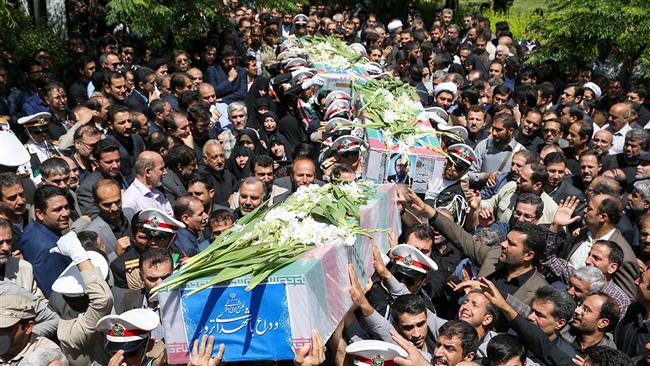
On the other end of the spectrum, Ayatollah Khamenei referred to the attacks as “firecrackers“. Officials from the civilian Rouhani administration also refused to jump to conclusions, instead following the more diplomatically inclined line that the Iranian President had laid out. Mahmoud Alavi, Minister of Intelligence, told media that “we still cannot judge if Saudi Arabia had a role in this terrorist action.“
Saudi Arabia’s foreign minister, Adel al-Jubeir, has denied Saudi Arabian involvement in the attacks. Al-Jubeir stated “we condemn terrorist attacks anywhere they occur and we condemn the killing of the innocent anywhere it occurs,” in response to the attack and the accusations.
Funerals for the victims are expected to be carried out throughout Friday, in keeping with the Islamic belief that a body must be buried as soon as possible. A procession for the security forces killed during the attacks is scheduled to begin outside of the Parliament building at 10 AM local time. Funeral of the civilian victims will be held at the southern public cemetery of Tehran, later in the day, during Friday prayer, with their coffins draped in the Iranian flag.
John Sjoholm, Lima Charlie News [Edited by May Hamza]
John Sjoholm is Lima Charlie’s Middle East Bureau Chief, Managing Editor, and founder of the consulting firm Erudite Group. A seasoned expert on Middle East and North Africa matters, he has a background in security contracting and has served as a geopolitical advisor to regional leaders. He was educated in religion and languages in Sana’a, Yemen, and Cairo, Egypt, and has lived in the region since 2005, contributing to numerous Western-supported stabilisation projects. He currently resides in Jordan. Follow John on Twitter @JohnSjoholmLC
Lima Charlie World provides global news, featuring insight & analysis by military veterans, intelligence professionals and foreign policy experts Worldwide.
For up-to-date news, please follow us on twitter at @LimaCharlieNews

